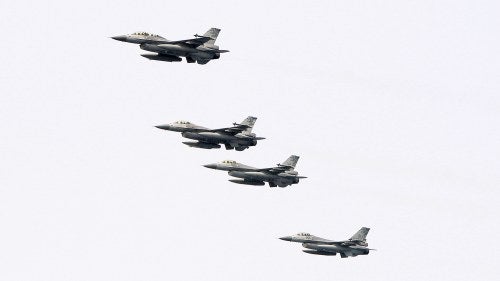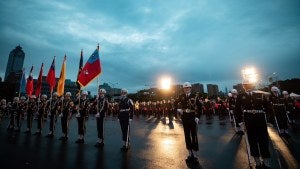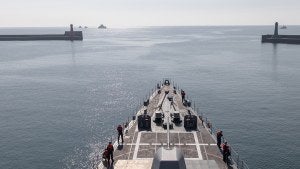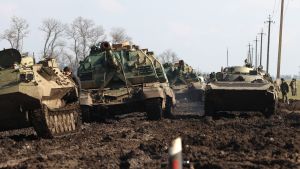Ukraine and Taiwan: Why Airpower and Air Defense Matter

American weapons play a key role in the defense strategies of both US partners.
The United States contributes to many foreign militaries around the world through arms sales, military-to-military training, and maintenance and support. Two US partners that have received substantial attention from both policymakers and the press are Ukraine and Taiwan. Though the defense needs of each partner are distinct, both have received US support in airpower and air defense capabilities. And both have continued to ask for more of this assistance.
To understand why, it helps to start with Ukraine and Taiwan’s security needs—both of which include airpower and air defenses. Ukraine, which Washington has backed with substantial military aid since Russia’s invasion in February 2022, benefitted early in the war from Russia’s failure to establish air superiority over the battlefield. If Russia achieved air superiority—which means its air forces would have free rein over the skies—it would be able to protect its own ground forces while substantially limiting Ukrainian forces’ ability to move. Although Russian air forces are still unable to operate freely over Ukraine, Moscow’s missile strikes have whittled down Ukraine’s air defenses (which shoot down enemy missiles and aircraft) and depleted Kyiv’s air defense ammunition. If Ukrainian air defenses are thinned out enough, Russia would be more likely to achieve air superiority, which would allow Moscow to use its deep reserves of unguided bombs on Ukrainian forces and civilians.
Air defense systems, like the S-300 system that Slovakia sent to Kyiv last spring or the National Advanced Surface-to-Air Missile System that the United States sent last October (bolstered by a recent US drawdown announcement), have helped Ukraine maintain an air defense network robust enough to prevent Russia from establishing air superiority. Since January, Kyiv’s perennial calls for Western fighter jets have grown louder, too—and, at the G-7 summit in May, US President Joe Biden said that he would let Ukraine get its long-desired F-16 fighter jets. US NATO allies will supply their US-made F-16s to Ukraine, whose pilots will train in the United States and Europe.
Though there’s little publicly available information on how Ukraine has used airpower in its summer counteroffensive against Russian forces, both air defense systems and fighter jets can help Kyiv prevent Russian aircraft from establishing air superiority in the long term. Air defense systems and aircraft are also key for countering Russian air and missile strikes, such as May’s large suicide drone attack on Kyiv. Moscow’s continued strike campaign in Ukraine has forced Kyiv to make hard choices—air defense systems deployed to the front lines cannot be used to protect civilian centers and infrastructure deeper in Ukraine. And Kyiv’s recent challenges with Russian attack helicopters have illustrated how important short-range air defenses are for protecting advancing Ukrainian forces.
Taiwan, a self-governing democracy which China claims as a rogue province, also finds airpower and air defense important. Most of its fighter jets and air defenses are US-supplied, such as the F-16 fighter jet that Ukraine will now acquire. China has threatened to blockade or invade Taiwan if it cannot reunify with it peacefully—and has an increasingly powerful military to back its threat. Also, Chinese planes and ships regularly fly near Taiwan’s coasts to reinforce the message that Taiwan belongs to Beijing. Taiwan’s government often intercepts Chinese forces with its own planes and ships to demonstrate its political sovereignty. Thus, unlike in Ukraine’s case, Taiwan’s airpower serves a political peacetime purpose, in addition to a potential wartime role.
There Are Limits to What US Arms Can Achieve
The United States plays a large role in sustaining both Ukraine’s and Taiwan’s airpower and air defense capabilities because the American know-how that goes into each weapon system is rare. Only a dozen or so countries make fourth-generation fighter jets such as the F-16. And even fewer countries produce advanced air defense missile systems, such as the US-made Patriot system that Taiwan and now Ukraine operate. Advanced fighter jets and air defenses are necessary for going up against militaries as large as Russia’s or China’s.
But staying in the fight is not the same as gaining an edge over the enemy. In the case of a Taiwan Straits war, it’s likely that air superiority would be wholly unachievable for Taiwan, even with significant intervention by US forces. China would have the advantages of operating in its backyard, sending out missiles and fighters from its relatively insulated interior, and fighting US forces very far from their home bases. So, Taiwan employs its F-16s much differently than the United States does. Washington uses fighter aircraft, including F-16s, for gaining air superiority and bombing ground targets, as it did in Kosovo, Iraq, Afghanistan, and Libya. Taiwan’s F-16s would stay on defense in a hot war since they would be unable to contest China’s air superiority.
Ukraine is a more ambiguous case. Russia’s poor performance on the ground and in the air over Ukraine means that US-supplied jets, along with Ukraine’s air defenses, may eventually be able make a difference in the fight for Ukraine’s skies. After all, after receiving advanced Western systems over the several months, Ukraine’s air defenses were reportedly able to intercept the majority of Russian missiles launched this May and June. But the F-16’s extensive training requirements mean that Ukraine’s air force will likely not deploy it until next year. Ukrainian pilots will also be transitioning from familiar Russian equipment to US-made systems, which requires adapting to new manufacturing, operating, and maintenance paradigms. In addition, the F-16 would also bring an entirely new logistics supply chain with its own challenges. Still, equipping Kyiv with F-16s is largely beneficial for longer-term objectives, such as bringing Ukraine into the worldwide network of US military aircraft now that it can no longer count on Moscow for its military equipment.
Though Ukraine’s air defense systems leave it in a better defensive position than Taiwan, Kyiv will still face challenges in operating against Russia given the latter’s layered air-defense systems. This could force Ukrainian pilots to fly at lower altitudes than are optimal for shooting down enemy aircraft. Russia could also use its cruise missiles to strike Ukrainian airbases housing F-16s, which would be small in number and thus easy to find because of the F-16 is a high-maintenance aircraft.
The Biden administration has committed to helping defend Taiwan and Ukraine, both of whom have substantial air defense and airpower demands. Though these demands differ somewhat because Ukraine is currently at war and Taiwan faces peacetime incursions by Chinese aircraft, both partners will likely continue to see the United States as an essential armorer.
Opinions expressed are those of the authors and do not reflect those of the US Navy, Department of Defense, or US Government.




Related Content
 Defense and Security
Defense and Security
Military conscription is a good start, but leaders in Taipei need to act with greater urgency still, Ethan Kessler writes.
 US Foreign Policy
US Foreign Policy
Washington has started selling arms that serve a "porcupine" defense strategy to Taiwan. Whether Taipei fully embraces this new approach remains to be seen.
 Defense and Security
Defense and Security
US aid would not have been nearly as effective without Ukraine’s efforts to improve its military prior to the 2022 Russian invasion.
